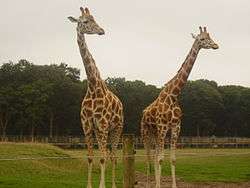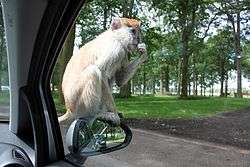Woburn Safari Park
|
Woburn Safari Park: Monkey sitting on the side-mirror of a car | |
| Date opened | 1970 |
|---|---|
| Location | Woburn, Bedfordshire, England |
| Coordinates | 52°00′18″N 0°35′20″W / 52.005°N 0.589°WCoordinates: 52°00′18″N 0°35′20″W / 52.005°N 0.589°W |
| Land area | 360 acres (150 ha)[1] |
| Memberships | BIAZA,[2] EAZA[3] |
| Website |
www |
Woburn Safari Park is a safari park located in Woburn, Bedfordshire, England. Visitors to the park can drive through the large animal exhibits, which contain species such as white rhino, elephants, tigers and black bears. It is part of the estates of the Duke of Bedford that also includes Woburn Abbey and its 3,000-acre (1,200 ha) deer park. The Safari Park itself covers 360 acres (150 ha).[1]
Woburn Safari Park is a member of the British and Irish Association of Zoos and Aquariums (BIAZA) and the European Association of Zoos and Aquaria (EAZA).
History
Woburn Safari Park was first opened in 1970, established by the 13th Duke of Bedford and Jimmy Chipperfield on the grounds of his estate, Woburn Abbey, as a means to help improve the financial position of the estate and restore the Abbey, which had fallen into disrepair as a consequence of the second world war and very high taxes levied by socialist Governments. The 11th Duke of Bedford had been president of the Zoological Society of London and had introduced various species such as American bison, deer, antelope, lion and tiger to the park.
Starting with upgrades to the wolf facilities in 2004 which allowed the wolves overnight access to the outside enclosure they share with the parks bears, the park had spent about £4 million by 2010 to upgrade off-show animal facilities in the park. The African Ungulate Conservation Centre (or "Antelope House") was built in 2007 to help conservation efforts with hoofed mammals, and what the park claims is "probably the biggest concentration of critically endangered African ungulates on Earth."[4]
The Asian Elephant Conservation Centre, built to house the parks elephants comfortably even through the winters, opened in 2008. It was followed in 2009 by a new facility for housing rhinos and other savannah animals, as well as an upgrade to the giraffe house that doubled its size.[4]
Animals

The park lets animals roam freely while visitors drive through their enclosures. The species held in the park include rhinoceros, elands, scimitar horned oryx, addax, gemsbok, giraffes, Ankoles, zebras, African wild asses, elephants, camels, bisons, bongo, lions, tigers, Canadian timber wolves, black bears, patas monkeys and Barbary apes.
The park also has a 40-acre (16 ha) leisure area featuring animal talks, petting zones, a gift shop, family restaurant and the Go Ape! 'high wire forest adventure' course. Animal in the leisure park include lemurs, squirrel monkeys, wallabies, emus, penguins, goats, ponies, reptiles and marmosets. It also has a soft play centre called Mammoth Play Ark.
Conservation

The park is committed to animal conservation and is involved in international breeding programs to help save endangered species, and includes one of the world's largest hoofstock facilities - The African Ungulate Conservation Centre, as well as an Asian elephant facility.
The park manages the breeding programme the mountain bongo,[5] and has been one of the most successful breeders of the Rothschild giraffe in Europe. Woburn is also the only zoo in the UK to hold Vietnamese sika deer - a species extinct in the wild.
In addition, Woburn Safari Park has been top fundraiser for EAZA in-situ conservation campaigns twice in the past 4 years. Woburn has won BIAZA's (British Association of Zoo's and Aquariums) for animal welfare for its management of sea lions (2008) and giraffe (2004) as well as winning the BIAZA award for Education and Marketing in 2008.
Other features
Woburn Safari Park is part of the Duke of Bedford's estate and when combined with the acreage of the deer park which surrounds the safari park (home to the endangered Pere David's deer), it represents the largest ex-situ conservation facility in Europe and the first 'captive' breeding facility to rescue a species from extinction in the wild with its success with the Pere David deer. Woburn was also instrumental in saving the Mongolian wild horse.
Developments
In 2010 the UK Department for the Environment, Food and Rural Affairs (DEFRA) criticised the park for keeping lions in overcrowded pens for up to 18 hours a day in winter, and keeping sea lions in chlorinated water.[6] However, DEFRA acknowledged that the park was already working to correct these issues and praised other newer facilities within the safari park. Although a new, larger overnight facility for lions was already under construction and would allow outside access to as well, Woburn Safari Park commented that even the old facility was large enough because the lions could move between the pens. Despite initial plans to move the sea lions to another park the animals were retained and a new biological water treatment system installed.[7] A new lion facility was completed in autumn 2010. A new tiger house was completed in 2013, with room for up to 9 tigers.[4]
Railway
There is also a 20 in (508 mm) railway, the "Great Woburn Railway" that (as of 2011) is free to use by Safari Park customers. It passes through a deer paddock containing fallow deer and a railway stop where you can alight and read educational signage and listen to keeper talks. The track is singular and consists of one near-circular loop.
References
- 1 2 Woburn Safari: Finding Us Retrieved 6 October 2014.
- ↑ "Find a Zoo". biaza.org.uk. British and Irish Association of Zoos and Aquariums. Retrieved 27 September 2010.
- ↑ "EAZA Member Zoos & Aquariums". eaza.net. European Association of Zoos and Aquaria. Retrieved 12 August 2010.
- 1 2 3 "New Lion House Breaks Ground as Sea Lions Move On and Penguins Move In!". woburn.co.uk. Woburn Safari Park. 9 February 2010. Retrieved 7 November 2010.
- ↑ "About Us". woburn.co.uk. Woburn Safari Park. Archived from the original on 2011-07-19. Retrieved 6 November 2010.
- ↑ "Woburn Safari Park criticised over 'crowded' lion pen". BBC News. 20 June 2010.
- ↑ Can’t get to the beach this summer? Come and see the sea lions instead! , 21 July 2011. Retrieved 15 September 2011
External links
| Wikimedia Commons has media related to Woburn Safari Park. |
| Wikimedia Commons has media related to Great Woburn Railway. |
